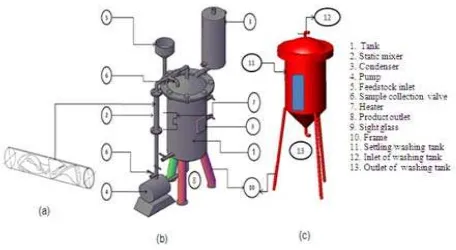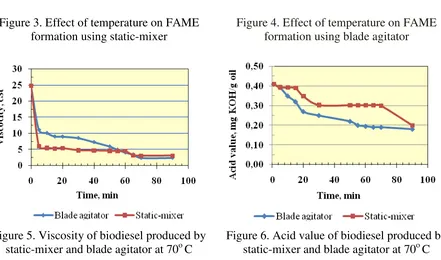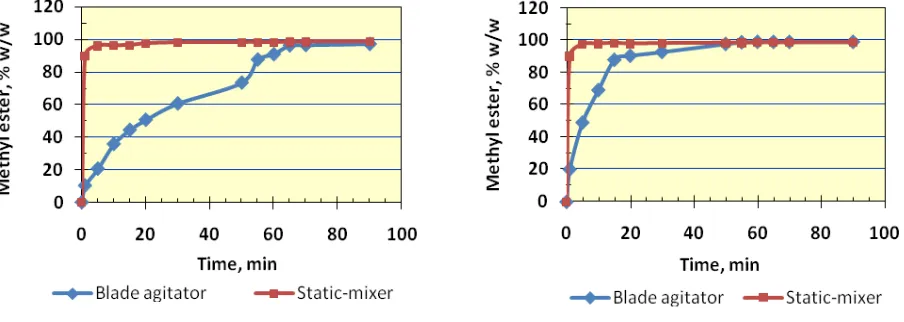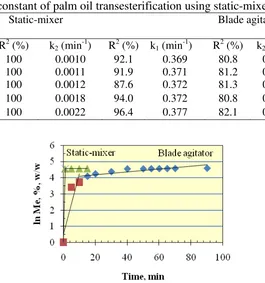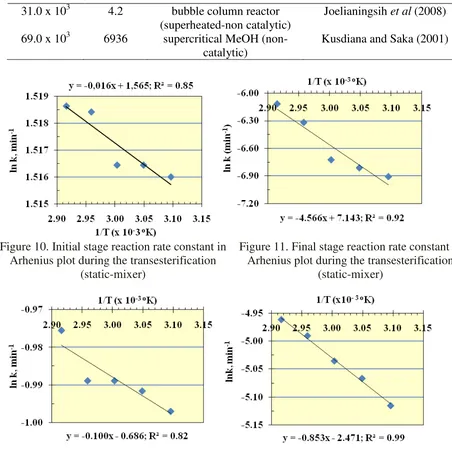Comparison of Static-Mixer and Blade Agitator Reactor in Biodiesel
Production
Rizal Alamsyah1) 2) , Armansyah H. Tambunan3), Y. Aris Purwanto3), Dadan Kusdiana4) 1)
Post Graduate (PhD) Student in Agricultural Engineering Science-Bogor Agricultural University (IPB), Darmaga Campus, P.O. Box 220, Bogor 16002, Indonesia 2)
Center for Agro-based Industry (CABI), Ministry of Industry, Jl. Ir. H. Juanda No. 11 Bogor 16122, Indonesia (rizalams@yahoo.com)
3)
Agricultural Engineering Sciences, Bogor Agricultural University, Indonesia 4)
Ministry of Energy and Mineral Resources, Indonesia ABSTRACT
One of the difficulties faced in the current technology for biodiesel production is the requirement for rigorous mixing of methanol with the feedstock oil in the reactor. Utilization of blade mixer has limitation due to the immiscible state of those substances. This research is devoted to the assessment of static-mixer utilization in a transesterification reactor for biodiesel production in terms of kinetics reaction (reaction rate coefficient k, activation energy Ea, and collision factor or coefficient factor A). The experiments were conducted by reacting palm oil (triglyceride or TG) with methanol (MeOH) at 50, 55, 60, 65, and 70o C, using potassium hydroxide (KOH) as catalyst. Molar ratio of TG and MeOH was 1 : 10.5 and KOH used was 1% of palm oil weight. Transesterification process using blade agitator with the same reaction condition was performed as base of comparison to those of static-mixer. The experiments showed that static-mixer has significant effect in reducing reaction time to reach required fatty acid methyl ester content (FAME) i.e. 96.5% than those of blade agitator. Transesterification reaction time with static-mixer were shorter than with blade agitator for all temperature levels. Reaction temperature of 65o C with 5 minutes of reaction time demonstrated the best condition for running the static-mixer reactor. The Static-static-mixer and blade agitator experiments exhibits two stages transesterification that gives the initial and the final activation energy (Ea1 and Ea2) and the initial and final collision factor (A1 and A2). The value of Ea1, Ea2, A1, A2 for static-mixer experiments were 0.13 J/mol, 37.1 J/mol, 4.8, and 1256 respectively. Meanwhile the value of Ea1, Ea2, A1, and A2 for blade agitator experiments were 0.81 J/mol, 6.9 J/mol, 2.0 and 11.8 respectively.
Keywords: Static mixer, blade agitator, activation energy, utilization, biodiesel, collision factor, transesterification.
I. INTRODUCTION
and reduction vehicle emissions (Wirawan, et al., 2008; Ajav, et al., 2002). Moreover biodiesel is non-toxic and biodegradable. The existence of biodiesel also is very useful mainly in the remote area of Indonesia where diesel fuel is not available and its price become very expensive. To produce biodiesel, catalytic and non-catalytic transesterification reactors have been developed by many researchers but the alkali-catalyzed process for biodiesel production is currently the method being implemented by biodiesel industry (Freedman et al., 1984; Noureddini and Zhu, 1997; Mittelbach and Remschmidt, 2004; Zhang, 2003; Kusdiana and Saka, 2001; Yamazaki et al., 2007). At present, the high cost of biodiesel is the major constrain to its commercialization. Numerous process and research for biodiesel production and reactor have been developed to reduce the high cost of biodiesel, especially for those methods concentrating on minimizing the raw materials cost and production cost as well. To be feasible, alternative fuel like biodiesel should be economically competitive when consumed, technically efficient when procressed, and ready available when needed (Mootabadi et al., 2008; Petterson, 1993).
2. LITERATURE REVIEW
One of the difficulties faced in the current technology for biodiesel production is the requirement for rigorous mixing of methanol with the feedstock oil in the reactor. Utilization of blade mixer has limitation due to the immiscible state of those substances. Long reaction time as caused by the low reaction rate is directly related to low collision frequency among reactants. This collision frequency can be enhanced by better mixing mechanism during the process. Most of industrial biodiesel reactor using blade agitator for mixing, which creates a main flow in the reaction tank with circulation on axial and tangential direction, and with little turbulency (Paul et al., 2003 ). Reaction time for alkali-catalyzed transesterification is about 60 – 90 minutes to obtain approximately 90–98% oil conversion to methyl esters (Zhang, 2003; Darnoko and Cheryan, 2000; Alamu et al., 2007).
Utilization of static-mixer to replace the blade agitator one is potential to improve the mixing process in biodiesel reactor. Static mixer is a motionless mixers, comprises of series of geometric mixing elements fixed within a pipe, which use the energy of the flow stream to create mixing between two or more fluids. Static-mixer perform a series of mechanism to mix reactants, namely dividing, rotating, channeling, or diverting the flow, before recombining it. Static-mixers create additional turbulence to enhance mixing. Static-mixers has been used to intensify physical and chemical processes in liquids, particularly the processes of gas and solid dissolution. Static-mixer mostly were applied in polymer processing. The power input to the mixing process is a result of pressure loss through the mixer (Oldshue, 1983; Paul et al., 2003 ). They are very effective in mixing liquids that are not readily miscible under normal conditions. Thompson (2007) has studied the possibilities of using static mixers as a continuous-flow reactor for biodiesel production in laboratory scale. Biodiesel (canola methyl ester) was produced under varying conditions using a closed-loop static mixer system. Sodium methoxide was used as the catalyst. Process parameters of flow rate or mixing intensity, catalyst concentration, reaction temperature, and reaction time were studied. The most favorable conditions for completeness of reaction were at 60° C and 1.5% catalyst for 30 min of transesterification reaction time. There is
mixer for two immiscible viscous fluids. A comparison of numerical results and measured data for flow mixing process in circular duct has been made to check the results of numerical simulations. The mixing efficiency function has been proposed to performed process optimisation and obtain most efficient conditions for industrial mixing process
This paper was aimed at assessing the kinetics transesterification reaction (reaction rate coefficient k, activation energy Ea, and collision factor A) using static-mixer reactor at different temperature levels of 50, 55, 60, 65, and 70o C. To examine its utilization, transesterification process using blade agitator was also conducted at the same temperature reaction levels and finally their results were compared and reviewed.
3. MATERIALS AND METHODS
3.1 Materials
Refined bleached deodorized Palm oil was obtained from PT. Royal Industries Karawang, West Java, Indonesia with the following characteristics: acid value was 0.41 mg KOH/g oil, saponification value was 212.9 mg KOH/g oil, free fatty acid or FFA was 1 mg KOH/g oil, moisture content was 0.3%, and density was 0.84 g/ml. MeOH 99% and KOH as catalyst were purchased from Setia Guna Co. Bogor, Indonesia.
Analytical grade of ethanol, toluene, chloroform, chloric acid, periodic acid, potasium iodide, potasium dichromate, fenolftaline indicator, oxalic acid, natrium borax, and Na2S2O3 were used to analyse the biodiesel quality . These materials were also obtained from Setia Guna Co. (Bogor, Indonesia) and were used to anallyze some quality parameters on biodiesel such as free glycerol, total glycerol, methyl ester, saponification value, acid number, and FFA based on AOCS Official Method. The reseach was conducted at March 2008 until April 2009 in Center for Research of Agro-based Industry (CABI) Ministry of Industry, Republic of Indonesia.
3.2 Static-Mixer Reactor /Vessel
Figure 1. (a) static-mixer, (b) reactor, and (c) washing tank
3.3 Experimental Procedures
Transesterification process was initially charged with palm oil (TG) in reactor tank and heated to the desired temperature (50, 65, 60, 65, or 70o C). These temperatures were selected due to boiling temperature of methanol (e.g. 64.5o C). Liquid MeOH was heated to desired temperature and pumped to the reactor tank. The reactions were conducted under atmospheric pressure with oil to methanol ratio 1:10.5. KOH used was 1% of the palm oil weight, and the excess of MeOH was given in order to make the reaction move to the products direction since methanolysis is a a reversible reaction. Based on this molar ratio, the volume of palm oil was 11 liters, MeOH was 5.5 liters, and KOH was 101 grams (the total volume of reactants was 16.5 liters).
(
As Aa . Gt)
/AsAs : Saponification value of biodiesel determined according to AOCS Official Method Cd 3-25 (mg KOH/g biodiesel)
Aa : Acid value of biodiesel determined according to AOCS Official Method Cd 3-63, (mg KOH/g biodiesel)
Gt : Total glycerol in biodiesel determined according to AOCS Official Method Ca 14-56 (% w/w)
Figure 2. Schematic flow diagram of the reactor used for transesterification experiments 4. RESULTS AND DISCUSSION
4.1 Reaction Rate
process. The experiments showed that static-mixer has significant effect in reducing reaction time to reach required fatty acid methyl ester content (FAME) i.e. 96.5% than those of blade agitator. Transesterification reaction time with static-mixer were shorter than with blade agitator for all temperature levels. This is also confirmed by the measured viscosity and acid value of the biodiesel from both agitation system, as shown in Fig. 5, and Fig. 6 respectively. This result is expected due to the distributive mixing from stsatic-mixer will create stretching, dividing and reorienting the flow of the reactants or biodiesel in order to eliminate local variations in material distribution and produce a more homogeneous mixture. Distributive mixers must impose high strain on the material together with splitting and reorienting the flow (Kenics, 2007). More over, the effect of reaction temperature to the reaction time is not significant when using the static-mixer. Conventional use of blade agitator is influenced highly by the reaction temperature as can be seen in Fig. 7 and 8.
Figure 3. Effect of temperature on FAME formation using static-mixer
Figure 4. Effect of temperature on FAME formation using blade agitator
Figure 5. Viscosity of biodiesel produced by static-mixer and blade agitator at 70o C
diglycerides (DG), which in turn reacts with MeOH to produce monoglyceride (MG), finally, MG reacts with MeOH to give glyceride (GL). At each reaction step, one molecule of ME is produced for each molecule of MeOH consumed.
Figure 7. FAME production using static-mixer and blade agitator at 50o C
Figure 8. FAME production using static-mixer and blade agitator at 70o C
Kusdiana and Saka (2001) defined a simpler mathematical model for overall reaction in transesterification reaction by ignoring the intermediate reaction (DG) and (MG), so the 3 steps can be simplified to be one step as follows (Fig.2):
ME
where k is the rate constant of the overall reaction in the transesterification reaction. It was assumed that reactant of MeOH will remain unchanged because of the excess of MeOH. This reaction is assumed to proceed in the first order reaction as a function of the concentration of triglycerides (TG) and reaction temperature. The rate constant can be determined based on the decreased amount of one reactant e.g. TG or alternatively based on the increased amount of the product that occurs in some reaction times interval (Barrow, 1973; Steinfeld et al, 1989). In this work, the reaction rate is predicted from the increase amount of one product, that is ME as can be described in Eq. (3)
where [ME] refers to the content of methyl esters that result after the treatment was carried out. Assuming that the initial concentration of ME=0 at time t= 0 and it increase to ME at some later time t, the integration gives Eq. (4) and (5), and finally k can be calculated based on Eq. (6).
[
]
Since the FAME production is obviously much faster at the initial stage of the process if using static-mixer, the reaction rate is evaluated in two stages, i.e. the initial rate (k1) and final rate (k2) for both mixing mechanism. The change from initial to final rate is rather arbitrary, but still the result shows consistency. The result of k values for static-mixer and blade agitator is shown in Table 1. The table clearly shows that the initial reaction rate (k1) by static-mixer are one order higher than that by blade agitator. However, the final reaction rate of blade agitator are higher than that by static-mixer, which is reasonable since the amount of reactant is still higher in the reactor. Figurative presentation of the reaction rate of the reaction rate as a comparison between the static-mixer and blade agitator for reaction temperature of 60o C is shown in Fig. 9.
Table 1. The rate constant of palm oil transesterification using static-mixer and blade agitator T
Figure 9. The concentration of ME in palm oil transesterification using static-mixer and blade agitator at 60o C
4.2 Activation Energy (Ea) and Collision Factor (A)
According to the Arhenius equation (Atkins, 1986), the correlation among constant rate, activation energy, and collision factors can be represented by Eq. ( 7):
WhereEa is the activation energy, R is the molar gas constant (0.00813 kJ mol-1 k-1) and A is the collision factor. The data in Table 1 were used to determine Ea and A from plot of k versus the reciprocal of absolute temperature (1/T) as shown in Fig. 10, 11 for static-mixer and 12 and 13 for blade agitator. The activation energy (Ea) and collision factor (A) as calculated from Eq. (7) for both initial and final stage of the reaction is given in Table 2. The table also shows the results from other studies. The value of Ea and A for the experiment, respectively was 0.13 J/mol and 4.78 min-1 at the initial stage and 37.12 J/mol and 1265 min-1 at the final stage, by using the static-mixer. It is difficult to compare the value with other studies due to the adoption of two stages of rates in this study.
The investigation in activation energy and reaction rate coefficient also conducted by Darnoko and Cheryan (2000) for palm oil in a batch reactor using KOH as catalyst at 60o C. Ea of for hydrolysis of monoglyceride (MG) and k during transesterification were found to be 0.026 kJ/mol and 0.141 min-1. In their experiments, the Ea was smaller and k value was higher than those in our experiments. In addition, the times required to reach standard methyl ester content was 90 minutes.
The constant rate of reaction rate for non-catalytic rapeseed oil transesterification in supercritical MeOH as reported by Kusdiana and Saka (2001) was 0.041 min-1 at 543o K and 12 MPa, while Ea and A were 69 kJ/kmol and 6936 min-1. The rate constant was higher than the value obtained in static-mixer experiments. The Ea and A value were also higher than those in our experiments. Comparing to this experiment result, the differencres are due to the reaction condition used. The Kusdiana and Saka’s experiment was performed under supercritical condition (40 Mpa), where the polarity of MeOH would decrease. As a result, non-polar TG can be solvated with supercritical MeOH to form a single phase of vegetable oil/MeOH mixture. Table 2 shows the results summary of energy activation and collision factor experiments from other sources.
The studies in activation energy and collision factor also reported by Joelianingsih et al. (2008) for palm oil transesterification in a bubble column reactor by semi batch reactor in absence of catalyst. In Joelianingsih experiments, transesterification reaction was done under atmospheric pressure, superheated MeOH vapor, and without stirring. Lower value of Ea and A were found to be 31 kJ/mol and 4.2 min-1respectively. While Joelianingsih experiment was done under MeOH bubbles are dispersed in oil phase, and the system consists of two phases. The reaction rate might be controlled by the mass transfer at the gas-liquid interface. These mixing mechanism consequently will influence the value of Ea, A, k and reaction time.
Table 2. Comparison of Energy activation (Ea) and Collision factor (A) Experimental Results
Ea(J/mol) A (min-1) Experiment stages
0.13 4.78 Initial stage static-mixer
37.12 1265 final stage static-mixer
0.81 2 initial stage blade agitator
6.93 11.83 final stage lade agitator
Previous Studies
Ea(J/mol) A (min-1) Methods Refeferences
31.0 x 103 4.2 bubble column reactor (superheated-non catalytic)
Joelianingsih et al (2008) 69.0 x 103 6936 supercritical MeOH
(non-catalytic)
Kusdiana and Saka (2001)
Figure 10. Initial stage reaction rate constant in Arhenius plot during the transesterification
(static-mixer)
Figure 11. Final stage reaction rate constant in Arhenius plot during the transesterification
(static-mixer)
Figure 12. Initial stage reaction rate constant in Arhenius during the transesterification (blade
agitator)
Figure 13. Final stage reaction rate constant in Arhenius during the transesterification (blade
agitator)
5. CONCLUSIONS
The following conclusion can be drawn from the transesterification experinments of biodiesel production from refined palm oil using static-mixer reactor and blade agitator:
− Transeseterification reaction time to reach standard methyl ester content by using static-mixer was faster than those by blade agitator, which indicates that mixing mechanism by static-mixer was more effective.
− The experiments results for static-mixer shows the value for Ea1, Ea2, A1, and A2 i.e. 0.13 J/mol, 37.1 J/mol, 4.8 min-1
, and 1256 min-1
. Meanwhile the value of Ea1, Ea2, A1, and A2 for blade agitator experiments were 0.81 J/mol, 6.9 J/mol, 2.0 min-1 and 11.8 min-1 respectively.
6. ACKNOWLEDGMENTS
This work was conducted between March 2008 and April 2009 at the Center for Reseach of Agro-based Industry (CABI) Bogor-Indonesia. This program was funded by Center for Industrial Education and Training - The Ministry of Industry Indonesia and The Indonesian International Education Foundation (IIEF). Grateful acknowledgements are made to these institutions for their support given to this research. Thanks and sincere gratitude are due to Prof. Kamaruddin Abdullah for his valuable support.
7. REFERENCES
Ajav, E.A. and A.O. Akingbehin (2002). “A Study of some Fuel Properties of Local Ethanol Blended with Diesel Fuel”. Agricultural Engineering International: The CIGR Journal of Scientific Research and Development. IV: EE 01 003.
Alamu, O.J., Waheed, M.A., Jekayinfa, S.O., and Akintola, T.A. (2007). “Optimal Transesterification Duration for Biodiesel Production from Nigerian Palm Kernel Oil”.
Agricultural Engineering International: the CIGR Ejournal. Manuscript EE 07 018. Vol.
IX. December.
Atkins PW (1986). Physical Chemistry. 3rd ed. New York: Oxford University Press Barrow GM. (1973). Physical chemistry. Tokyo: McGraw-Hill Kokusha Ltd, (p. 419).
Best, G. (2006). “Alternative Energy Crops for Agricultural Machinery Biofuels – Focus on Biodiesel”. Agricultural Engineering International: The CIGR Journal of Scientific Research and Development. Invited overview. VIII(13).
Darnoko D., Cheryan M. (2000). Kinetics of palm oil transesterification in a batch reactor. J Am Oil Chemists’ Soc 77(12):1263–7.
Freedman, B., Pryde, E.H., Mounts, T.L., (1984). “Variables affecting the yields of fatty esters from transesterified vegetable oils”. J. Am. Oil Soc. Chem. 61: 1638–1643.
Jaszczur, M., Szmyd, J., Petermann, M. (2009). “An analysis of mixing process in a static mixer”
(acce-ssed at December 10, 2009)
Joelianingsih, Maeda, H., Hagiwara, S., Nabetani, H., Sagara,Y.,. Soerawidjaya, T.H., and Tambunan, A.H. and Abdullah K. (2008). Biodiesel fuels from palm oil via the non-catalytic transesterification in a bubble column reactor at atmospheric pressure: A kinetic study Renewable Energy 33: 1629–1636
Kusdiana D, Saka S. (2001). “Kinetics of transesterification in rapeseed oil to biodiesel fuel as treated in supercritical methanol”. Fuel 80: 693–698.
Meher, L.C., Vidya Sagar, D. and Naik, S.N., (2006). Technical aspects of biodiesel production by transesterification. Renew. Sustain. Energy Rev., 10, p. 248-268.
Mittelbach, M. and C. Remschmidt. (2004). Biodiesel: The comprehensive handbook. 1st Ed”. Boersedruck Ges.m.b.H. Vienna.
Mootabadi, H,, Salamatania, B., Razali, N.Bathia, S., and Abdullah, A.Z. (2008). “Energy Balance Production of Biodiesel”. Paper presented on International Conference on
Environmental Research and Technology (2008)
Noureddini, H., Zhu, D., (1997). “Kinetics of transesterification of soybean oil”. J. Am. Oil Soc. Chem. 74: 1457–1463.
Oldshue, J.Y. (1983). Fluid Mixing Technology. Chemical Engineering Mc Graw-Hill Pub. Co, New York.
Paul, E., Obeng, V.A.A., dan Kresta, S.M. (2003). Handbook of Industrial Mixing. Wiley-Interscience, New York.
Peterson, C.L., (1993). “Commercial process feasibility analysis and bench scale process system design”. University of Idaho, Departments of Agricultural Engineering and Chemical Engineering, US Department of Energy Agreement No. DE-B179-93BPO9233. NTIS, Springfield, VA, 15 pp.
Steinfeld JI, Francisco JS, Hase WL. (1989). Chemical kinetics and dynamics. New York: Prentice Hall, (p. 6).
Thompson, J.C. and He, B.B. (2007). “Biodiesel Production Using Static Mixers”, Transactions of the ASABE 50(1): 161−165
Wirawan, S.S., A.H. Tambunan, M. Djamin, and H. Nabetani (2008). “The Effect of Palm Biodiesel Fuel on the Performance and Emission of the Automotive Diesel Engine”. Agricultural Engineering International: the CIGR Ejournal. Manuscript EE 07 005. Vol. X. April, 2008.
Yamazaki R, Iwamoto S, Nabetani H, Osakada K, Miyawaki O, Sagara Y. (2007). “Noncatalytic alcoholysis of oils for biodiesel fuel production by semi-bach process”. Jpn J Food Eng. 8:11–9.
